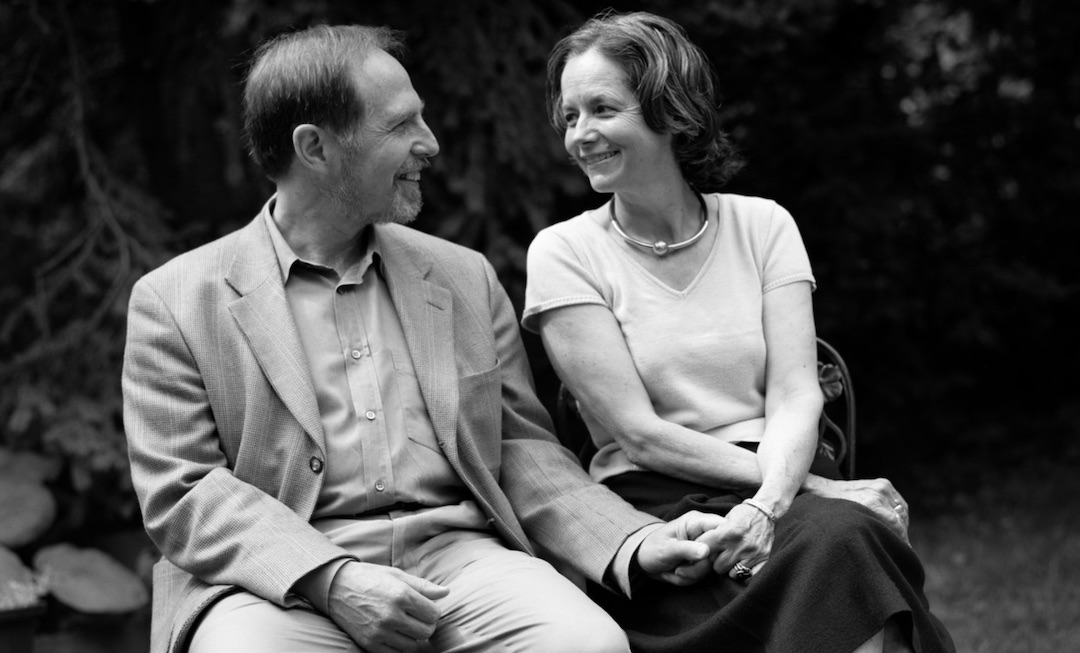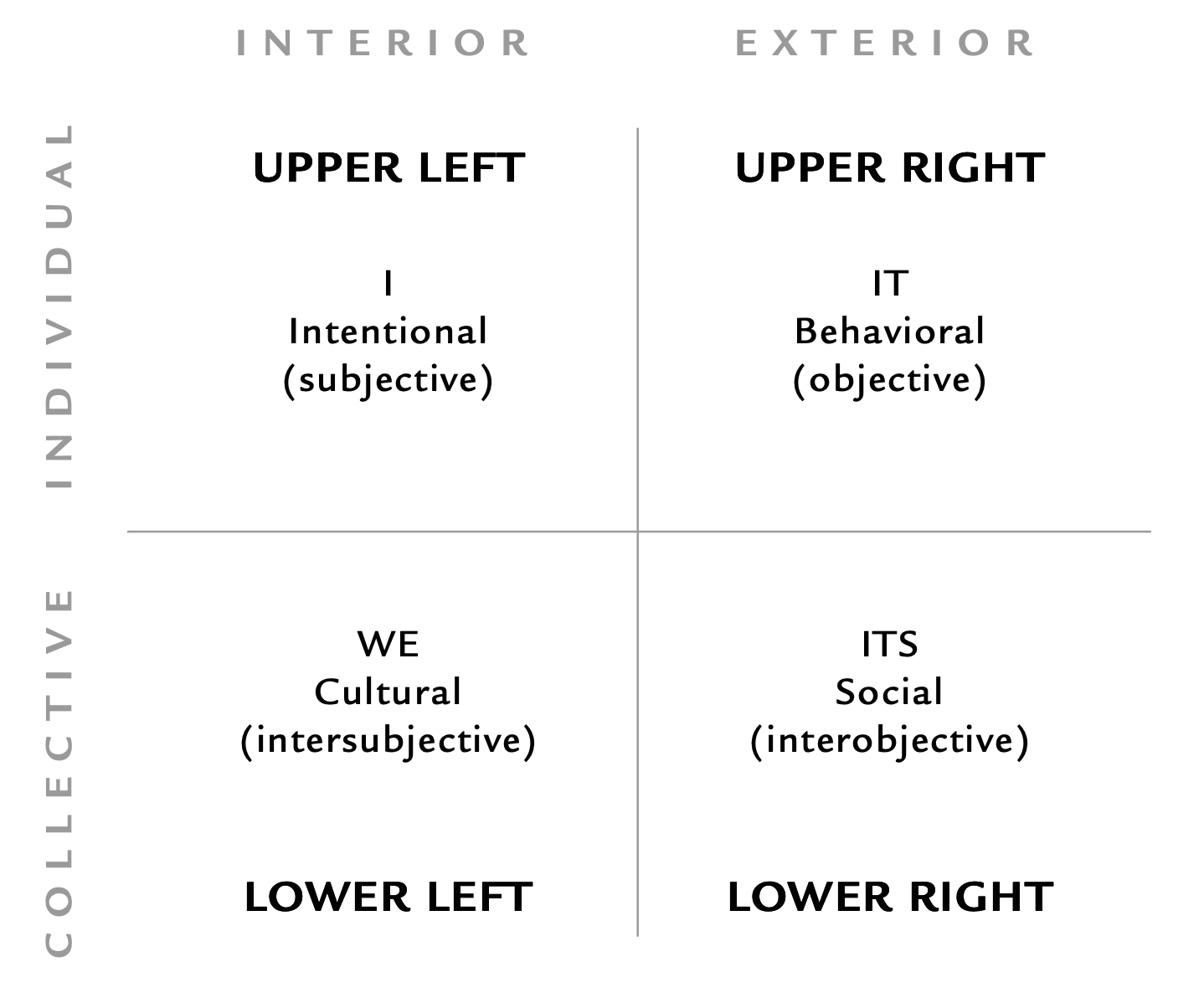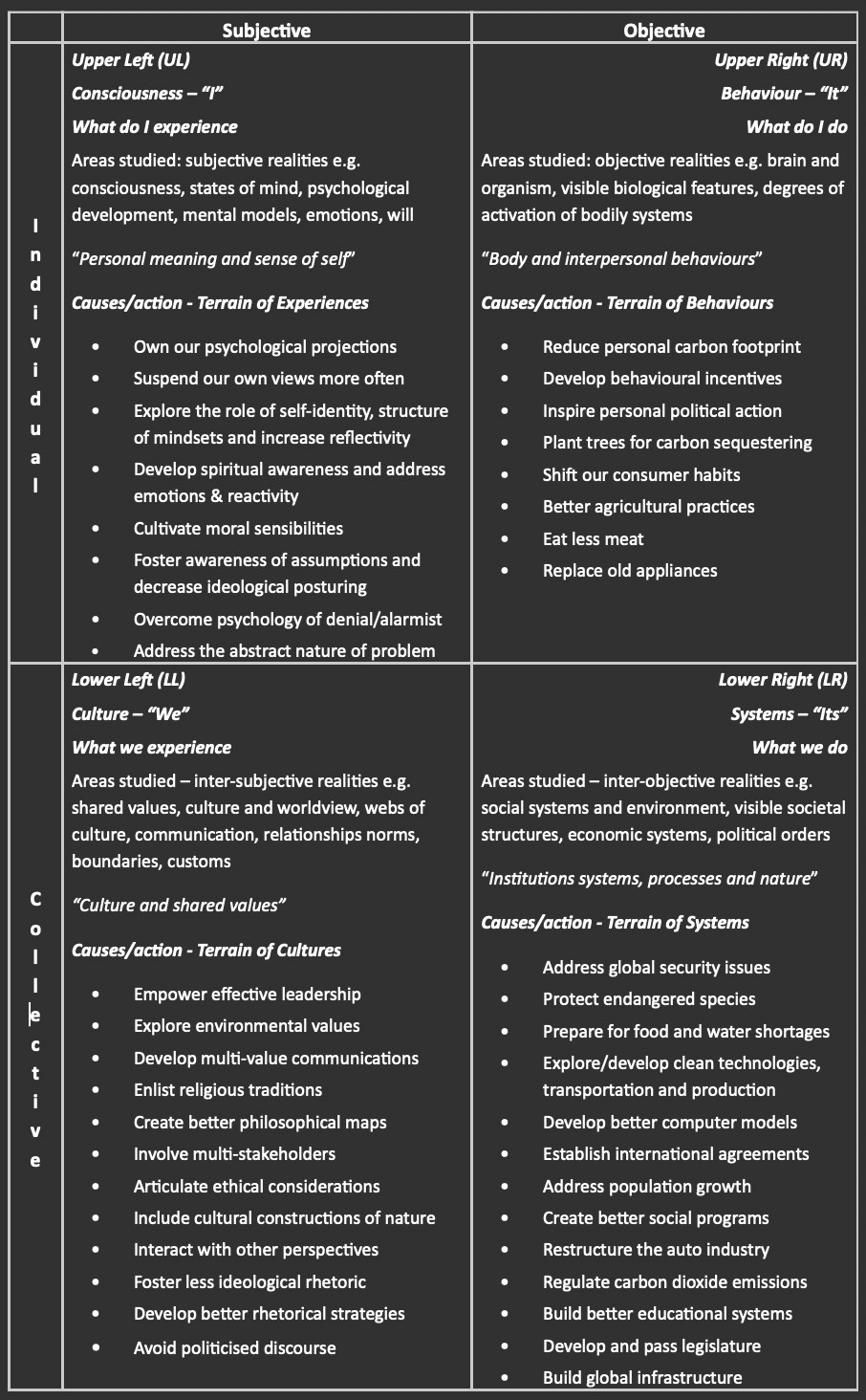Integral theory: surprisingly simple, elegant
The word integral means comprehensive, inclusive, non-marginalizing, embracing.
Integral approaches to any field attempt to be exactly that: to include as many perspectives, styles, and methodologies as possible within a coherent view of the topic—Ken Wilber
Integral
The American philosopher, Ken Wilber, is famous for creating Integral Theory. It is a map of all human knowledge which Ken says turns “out to be surprisingly simple and elegant”.
It does this with 5 elements—quadrants, levels, lines, states and types. These encompass the growth and evolution of today’s society and help us to address stuck problems, see possibilities and address difficult paradoxes.
Of the five elements, two—quadrants and levels—are most commonly used. Quadrants address two splits in our world. The first is subjective (the hard to quantify things such as emotions and cultural norms) v’s objective (commonly measured metrics such as the time I need to travel to work or for a country, gross domestic product). The second is individual (you or I) v’s collective (you and your family, citizens of a country).
Subjective and objective
Integral theory argues that trying to describe phenomena—such as the difficulty of explaining decision-making and action from a purely objective perspective—is akin to a flatland. It divorces meaning and purpose from human activities, business or social endeavors. For example, we choose to buy things both on emotional response (say to fruit that smells and looks good) and price. Consequently, the framework explicitly recognizes such objective perspectives alongside the subjective factors—those that are less immediately quantifiable and/or are non-measurable.
Individual and collective
Individual values and personal financial motivation are clear factors to be considered within many investigations. Equally, within a business, organization or society collective systems include culture-style influences, shared or tacit value systems. In the more measurable objective sphere, business capital expenditure prioritization or country economic policy provides direction to, and influence on, decisions.
All four together
The subjective and objective aspects above both have individual and collective facets. Consequently, the combinations are a four-part structure. Together, there are four possible combinations of these:
- The Upper-Left usually representing individual-subjective viewpoints (for example, personal values, spiritual beliefs and emotions)
- The Lower-Left usually representing collective-subjective viewpoints (inter-subjective—for example worldviews, culture and group norms)
- The Upper-Right usually representing individual-objective viewpoints (for example objective reality – measurements made of a human brain when the subject is undertaking a specific behavior)
- The Lower-Right usually representing collective-objective viewpoints (inter-objective – for example objective reality – visible social structures such as the economic system).
For Integral theory proponents, these four pieces are essential. Integral holds that any given phenomena have all four perspectives.

I’ll tell you a story
After his beloved wife was diagnosed with Alzheimer’s, Arthur Kleinman discovered that what he didn’t know was a lot. The story is full of soul. This extract illustrates our objective blindspots. Arthur says:
There is this excellent exoskeleton for the legs. We took this idea to the many elderly women in Shanghai living in high-rise apartments. We showed them illustrations of how this works. They said, “Wow, fantastic, but I’d never use it.” We asked why. They said, “It’s so dangerous to cross the road here. Cars don’t stop. We wouldn’t trust it. But if you really want to help us, we have six friends, all in similar conditions in different apartment buildings here in Shanghai. We would like to twice a week get together and go to a tea house. …
We had it all backwards. That becomes an interesting issue for technology and anthropology. Maybe the exoskeleton would be useful in this instance, but if so, probably not the legs, but for the arms of a carer to get them from a 12th floor to a lobby of a building, and doing this for six people. How do you organize this? Is it a van? Who goes with them? How does the actual human experience come together with the technology? That’s the project we now have.
Integral theory quadrant illustrations (above and below).

Levels
Levels stand for development through discrete stages. Such levels are often outlined for individuals and how we make sense of what goes on around us. They exist across all the integral quadrants above.
An example of levels for individual people is that development unfolds in a defined, identifiable and invariable sequence. People move through specific stages or orders within which we understand ourselves (and what we experience in the world) within describable parameters.
As a person shifts, from one stage to a new order, the new level includes previous orders and thus must be more complex to support this more comprehensive understanding. A person would thus make sense of themselves and the world in a holistic manner when at a particular stage and then, in a subsequent order, this prior understanding forms part (but not all) of their new meaning-making.
That is, the new meaning-making stage transcends and includes the previous steps – it transcends its previous level of knowledge but still includes this knowledge. Such cognitive stages are similarly linked to physical perspectives – for example, perceptions and objective statements about why we should, or should not, act on climate change and/or peoples’ ways of defining sustainability.
States, Lines, Types
Other aspects of integral theory are states, lines and types. In brief:
- States are temporary manners of being or external conditions.
- The concept of multiple lines is common in developmental that may include cognitive, moral and emotional development. For example, Robert Kegan and Susanne Cook-Greuter have each described such growth hierarchies. These separate descriptions could be regarded as such discrete lines of development.
- Types describe typically fixed preferences. For example, a person’s Myers-Briggs type, it is argued, does not change. However, the non-preferred way of being may be learned.
Integral theory’s proponents hold that utilizing all elements in any situation increases the likelihood of better understanding and/or successful outcomes.
Integral theory can be, and is, applied to a wide range of human endeavor including sustainability and related topics, leadership, management, organizations and future studies.
Revolutionary
One of the things that makes integral theory stand out is its comprehensive map of the world. It helps us understand paradoxes such as profitability. In this paradox, we say we will act when it is in our financial self-interest to do so. However, numerous examples of cost-effective, quick, risk-free, profitable changes that are not acted on exist.
Levels help us make sense of wildly different perspectives. For example, sometimes I become frustrated with a dogmatic, my way or the highway, approach. Google Glass is a good example. Technically brilliant, a useful idea but, oops, we forgot about integrating more complex, sophisticated and subtle perspectives. Is the person wearing this spying on me, being a glasshole?
The quadrants and some examples from each area above (click to open).

Old people will save the world
Humans are at a unique point in history. We are both the makers of our own peril, we know we are in a peril race and, at the same time — with greatly expanded lifespans and wisdom that this may bring with age — we have the capacity to address this.
Humans shift through stages of understanding. We can become distinctly more aware of our thoughts and feelings as we make such changes. More here>
Resources
Links and posts
Try this interactive quadrant tour, the Formless Mountain’s quadrants, here >
For a longer overview of integral theory see An All-Inclusive Framework for the 21st Century by Sean Esbjörn-Hargens pdf here >
A great book length, relatively easy read, introduction to Integral Theory is Ken Wilbur’s A Brief History of Everything here >
Arthur Kleinman’s quote is from his interview in the Harvard Gazette, How a doctor learned to become a caregiver, here >
Table of quadrant examples from A Climate for Change here > You’ll find many examples of great projects, outcomes and applied integral impact on this website, Integral tag, here >
Feature image is via Barrett Brown; Quadrant illustration: 1, Formless Mountain; 2, Sean Esbjörn-Hargens; Arthur and Joan, The Harvard Gazette.
Ken Wilber on Integral Theory
Subscribe
Get the newsletter (story summary).
Recent posts
Coming home
We belong to and are of the Earth but we bypass our sense of belonging. I missed this leaving home and my story mirrors our larger, human-wide journey. What do I need to come home?
Soulprint: Peak nature
Extraordinary: a paradigm shift by 147 governments and the UN endorsing “humans and nature are spiritually connected.” Invitation: to build on this for yourself and all of us.
We are in a portal
I’ve a deep knowing: we humans have shifted. That’s disorienting so here’s 3 handrails to help: this is sourced in bliss; lubricated by peak oil; agreed by UN & 147 nations; and, all with dragonflies!



0 Comments